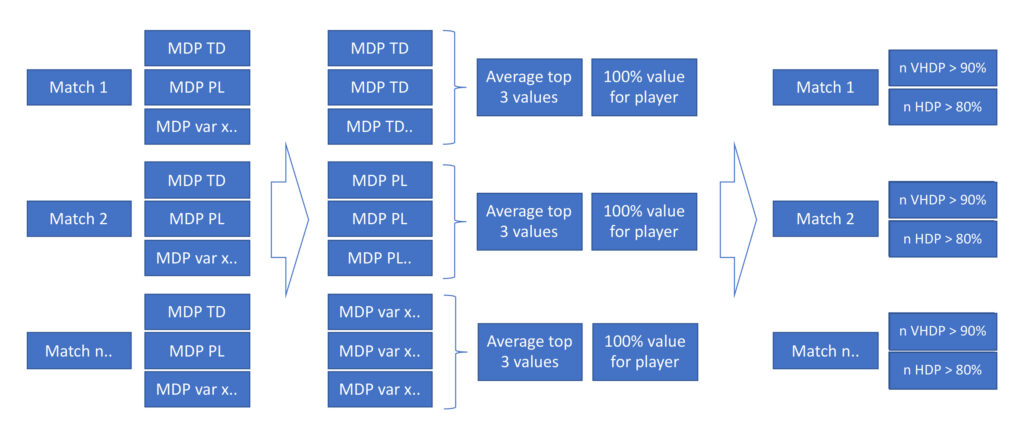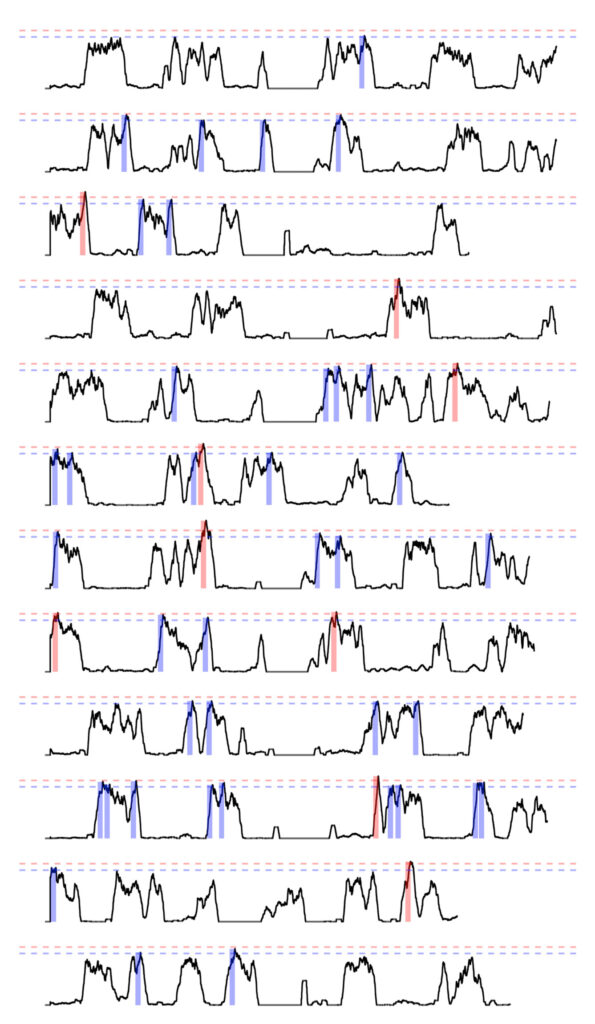Most Demanding Passages in Elite Futsal: An Isolated or a Repeat Situation?
*Correspondència: Jordi Illa jordi.illa@fcbarcelona.cat
Citació
Illa, J., Fernández, D., Tarragó, J.R., & Reche, X. (2020). Most Demanding Passages in Elite Futsal: An Isolated or a Repeat Situation? Apunts. Educación Física y Deportes, 142, 80-84. https://doi.org/10.5672/apunts.2014-0983.es.(2020/4).142.10
Abstract
The main purpose of this research was to examine not only the most demanding passages (MDP) of elite futsal matches through different external load variables: total distance covered (TD), distance covered at high-speed running (HSR), metres covered above 0.02 Player Load (PL), number of high-intensity accelerations (ACC) and decelerations (DEC); but also to analyse whether they may be repeated in the course of a single match for a single player. Data from one professional futsal player were collected using a local positioning system from a total of twelve official matches of the 1st Division of the Liga Nacional de Futbol Sala (LNFS) during 2018-2019. The rolling average method was used for all variables, using a one-minute time window. Data were re-analysed to identify the very high demanding passages (VHDPs; >90% of the mean of the three top MDP of all matches) and the high demanding passages (HDPs; 80%-90% of the mean of the three top MDP of all matches). The results showed that the VHDPs and HDPs in a single match did not present as an isolated situation. TD and ACC were the two most demanding variables in terms of repetition of HDPs and VHDPs.
Introduction
Monitoring players’ exposure to training and competition loads has become a regular activity in the daily work of sport scientists and strength and conditioning coaches. Recently, increasingly greater attention has been paid to the most demanding passages (MDPs) of matches in different team sports, with several studies using different methodologies such as dividing the match into predefined periods of 15 minutes (Carling & Dupont, 2011) or 5 minutes (Bradley & Noakes, 2013; Di Mascio & Bradley, 2013) and the rolling average method in different team sport research (Delaney et al., 2017; Fernández et al., 2020; Malone et al., 2017). An MDP of a match could be described as a multifactorial phenomenon that occurs within a defined time period, in which all the conditional and emotional variables are more demanding than at any other moment in a game (or training session) (Fernández et al., 2020), and the rolling average method seemed to be the best method for describing these scenarios (Delaney et al., 2017).
Hitherto, most of the studies that have addressed MDPs have sought to identify only one scenario per match, without entertaining the possibility of having 2 or more scenarios of the same (or almost the same) magnitude. This possibility could be described as the repetition of MDPs, or if the values of performance are lower than an MDP, as the repetition of very high demanding passages (VHDPs) and high demanding passages (HDPs). Considering futsal as an intermittent sport in which the combination of high-intensity actions and low-intensity short pauses exposes players to a major amount of high physiological, mechanical and locomotor stress (Dogramaci et al., 2011), the identification and comprehension of the repeatability of VHDPs and HDPs may be of great assistance to sports scientists, strength and conditioning coaches and other technical staff members to have a better understanding of the demands of the competition and therefore to better adjust training loads in a quantitative and qualitative perspective (Sánchez-Ballesta et al., 2019).
Thus, the objectives of this study were (1) to describe the concept of repetition of VHDPs and HDPs in games by defining the concept of VHDPs and HDPs and (2) to identify how many of these scenarios were present in official games for an elite professional futsal player.
Method
A retrospective observational study was conducted during the 2018-2019 season. Data were collected from one professional futsal player (age: 26 years, weight: 67.5 kg, height: 171.3 cm) from Futbol Club Barcelona with the ultra-wideband (UWB) local positioning system (WIMU PRO™, RealTrack Systems S.L., Almería) from 12 official matches of the Liga Nacional de Futbol Sala (LNFS) 1st Division. The data analysed stemmed from daily player monitoring, in which player activities are measured routinely in the course of the season. Therefore, the approval of an ethics committee was not required (Lacome et al., 2018), although the study was conducted in accordance with the Declaration of Helsinki, and the player provided his informed consent before participating. The logging device was located in the upper part of the back on a tight-fitting vest. The data collected were analysed with computer software (SPRO, RealTrack Systems S.L., version 946) and computed by the data computation software RStudio version 1.2.5033 (RStudio, Inc.) for Windows version 10 Pro. The WIMU PRO™ sensors are equipped with three different inertial sensors: accelerometer, gyroscope and magnetometer, a GPS (10 Hz sample frequency) and a UWB (18 Hz sample frequency). The WIMU PRO™ presented both good/acceptable accuracy and inter- and intra-unit reliability for UWB positioning (Bastida-Castillo et al., 2019).
The rolling average method was used for all variables to determine the MDP of each game. The maximal values for a one-minute time window were calculated and presented for each variable: total distance covered (TD; m·min-1), distance covered at high-speed running (HSR; >18km·h-1; m·min-1), metres covered above 0.02 Player Load (vector magnitude expressed as the square root of the sum of the squared instantaneous rates of change in acceleration in each one of the 3 planes divided by 100 in arbitrary units) (PL; m·min-1), the number of high-intensity accelerations (ACC; >2 m·s-²; n·min-1) and the number of high-intensity decelerations (DEC; >2 m·s-²; n·min-1). Once the MDP of each variable and each game had been determined, the average of the three highest values for each variable was calculated to determine the player’s 100%; and the definition of the very high demanding passage (VHDP) threshold (>90% of the mean of the three top MDP) and the high demanding passage (HDP) threshold (80%-90% of the mean of the three top MDP) was established. Finally, a new computing process was conducted to identify all the VHDPs and HDPs for a one-minute time window in each game for each variable (figure 1).

The results were expressed as the mean number of VHDPs and HDPs occurring for each variable plus the standard deviation (mean ± SD), and the range (minimum and maximum) of number of scenarios per match observed. No other statistical test was conducted because this was a one-player case study and there were no differences to evaluate.

Results
Table 1 displays all the mean values and the SD of the number of VHDPs and HDPs for each variable per game. The results showed that TD was the variable with the greatest number of VHDPs and HDPs in a competitive match; and the range values of the variables showed that there might not be any VHDP or HDP in a match or that there might be several VHDPs and HDPs. Figure 2 shows the stochastic distribution among games suggested by the results of table 1, with games without any scenario and with games with several scenarios.

Conclusions
The main purpose of this research was to examine not only the MDPs of elite futsal official matches but also to analyse the possible repeatability of similar scenarios (VHDPs and HDPs) and to quantify how many times a player is exposed to them in a single match. The main findings were: (1) the VHDPs and HDPs of a single match did not present as an isolated situation and there was a high variation of each variable between matches; (2) considering match MDPs could help to understand the concept of repeatability of VHDPs and HDPs and (3) TD and ACC were the most repeated HDPs and MDPs of all the variables analysed in a single match.
To our knowledge, this is the first research to address the concept of the repetition of MDPs, the concept of the repetition of MDPs and the concept of establishing thresholds to separate VHDPs from HDPs. It is important to point out that this last concept could constitute a limitation of our research, since the lack of previous research led us to establish an 80% threshold for HDPs and a 90% threshold for VHDPs on the strength of our experience.
The findings of this research point the way for future research analysing the repeatability of VHDPs and HDPs in a match for different professional futsal players and to analyse whether these scenarios present during their training sessions. This may help coaches and strength and conditioning coaches to design, adjust and modify training drills to optimise performance to meet the high demands of competition.
Acknowledgements
The authors would like to thank the team and the athlete who participated in the study. The authors did not report any potential conflicts of interest. This work was not supported by a funding source.
Referències
[1] Bastida-Castillo, A., Gómez-Carmona, C. D., De la Cruz-Sánchez, E., Reche-Royo, X., Ibáñez, S. J., & Pino Ortega, J. (2019). Accuracy and Inter-Unit Reliability of Ultra-Wide-Band Tracking System in Indoor Exercise. Applied Sciences, 9(5), 939. https://doi.org/10.3390/app9050939
[2] Bradley, P. S., & Noakes, T. D. (2013). Match running performance fluctuations in elite soccer: Indicative of fatigue, pacing or situational influences? Journal of Sports Sciences, 31(15), 1627-1638. https://doi.org/10.1080/02640414.2013.796062
[3] Carling, C., & Dupont, G. (2011). Are declines in physical performance associated with a reduction in skill-related performance during professional soccer match-play? Journal of Sports Sciences, 29(1), 63-71. https://doi.org/10.1080/02640414.2010.521945
[4] Delaney, J. A., Thornton, H. R., Burgess, D. J., Dascombe, B. J., & Duthie, G. M. (2017). Duration-specific running intensities of Australian Football match-play. Journal of Science and Medicine in Sport, 20(7), 689-694. https://doi.org/10.1016/j.jsams.2016.11.009
[5] Di Mascio, M., & Bradley, P. S. (2013). Evaluation of the Most Intense High-Intensity Running Period in English FA Premier League Soccer Matches. Journal of Strength and Conditioning Research, 27(4), 909-915. https://doi.org/10.1519/JSC.0b013e31825ff099
[6] Dogramaci, S. N., Watsford, M. L., & Murphy, A. J. (2011). Time-Motion Analysis of International and National Level Futsal. Journal of Strength and Conditioning Research, 25(3), 646-651. https://doi.org/10.1519/JSC.0b013e3181c6a02e
[7] Fernández, D., Novelles, A., Tarragó, R., & Reche, X. (2020). Comparing the Most Demanding Passages of Official Matches and Training Drills in Elite Roller Hockey. Apunts. Educación Física y Deportes, 140, 77-80. https://doi.org/10.5672/apunts.2014-0983.es.(2020/2).140.11
[8] Lacome, M., Simpson, B. M., Cholley, Y., Lambert, P., & Buchheit, M. (2018). Small-Sided Games in Elite Soccer: Does One Size Fit All? International Journal of Sports Physiology and Performance, 13(5), 568-576. https://doi.org/10.1123/ijspp.2017-0214
[9] Malone, S., Solan, B., Hughes, B., & Collins, K. (2017). Duration specific Running performance in Elite Gaelic Football. Journal of Strength and Conditioning Research. https://doi.org/10.1519/JSC.0000000000001972
[10] Martín-García, A., Casamichana, D., Díaz, A. G., Cos, F., & Gabbett, T. J. (2018). Positional Differences in the Most Demanding Passages of Play in Football Competition. Journal of Sports Science & Medicine, 17(4), 563-570.
[11] Martín-García, A., Castellano, J., Méndez Villanueva, A., Gómez-Díaz, A., Cos, F., & Casamichana, D. (2020). Physical Demands of Ball Possession Games in Relation to the Most Demanding Passages of a Competitive Match. Journal of Sports Science & Medicine, 19(1), 1-9.
[12] Sánchez Ballesta, A., Abruñedo, J., & Caparrós, T. (2019). Accelerometry in Basketball. Study of External Load during Training. Apunts. Educación Física y Deportes, 135, 100-117. https://doi.org/10.5672/apunts.2014-0983.es.(2019/1).135.07
ISSN: 2014-0983
Rebut: 13 d'abril de 2020
Acceptat: 25 de juny de 2020
Publicat: 1 d'octubre de 2020
Editat per: © Generalitat de Catalunya Departament de la Presidència Institut Nacional d’Educació Física de Catalunya (INEFC)
© Copyright Generalitat de Catalunya (INEFC). Aquest article està disponible a la url https://www.revista-apunts.com/. Aquest treball està publicat sota una llicència Internacional de Creative Commons Reconeixement 4.0. Les imatges o qualsevol altre material de tercers d’aquest article estan incloses a la llicència Creative Commons de l’article, tret que s’indiqui el contrari a la línia de crèdit; si el material no s’inclou sota la llicència Creative Commons, els usuaris hauran d’obtenir el permís del titular de la llicència per reproduir el material. Per veure una còpia d’aquesta llicència, visiteu https://creativecommons.org/licenses/by/4.0/deed.ca



